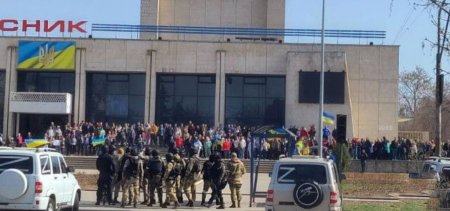 |
| 4-April-2022 |
Q: Do you think that the Kremlin’s aims have changed in the month since the invasion started?
PL: I am convinced that Putin’s aims remain the same. He wants to destroy Ukraine, having split it into pieces. Now, for example, he is trying to set up a “Kherson people’s republic”, which he would then recognise in future. Then, I reckon, they will try to set up something like a “union of people’s republics”. Putin will not touch the territories that border Poland, Slovakia, Hungary and Romania, for the simple reason that the Russian federation needs an external enemy in the shape of the regions that stay within Ukraine. Putin’s main aim is that the Ukraine of 2014-2022 – the free and independent Ukraine – should disappear.
Q: You have spoken before about the danger of the Russian federation issuing passports to Ukrainians. How actively is this policy being pursued now?
PL: It’s more operational than ever. Now that the Donetsk and Luhansk “people’s republics” have been recognised by Russia, no-one now has to travel to Rostov region (of southern Russia, to apply for a passport). “Migration departments” have been set up in the occupied territories for passports to be issued. And now they (the Russian authorities) are increasing the numbers on account of the areas of Luhansk and Donetsk they have recently seized (i.e. areas that remained under Ukrainian government control between 2014 and 2022). And the approach has changed. Now those who refuse (a passport) are intimidated on account of it being war time, and threatened with legal cases for “collaboration with Ukraine”. A little more than a million such passports have now been issued.
 |
| Demonstrators gathering in Enerhodar. Zaporizhiya region, on Saturday 2 April to protest at the Russian occupation. After this photo was taken they were violently dispersed by the occupation forces |
Q: Now the Russians are “evacuating” citizens of towns they have occupied in Starobelsk and Svatovo. What are their aims?
PL: They need to create a “picture” for domestic consumption in the Russian federation, showing that “our brave army is saving peaceful civilians”. Unfortunately there are cases where they have evacuated people from Rubezhny and Svatovo to Rostov region. Where they go from there, we don’t know. Communication breaks down.
I suspect that our citizens could be sent, for example, to Vorkuta (a mining town north of the Arctic circle) or to the Far East (of Russia). Remember that the Russian federation has a big problem of a great deal of territory that is sparsely populated. This is one way of trying to address it, where the “fellow countryman” programme of the Russian foreign affairs ministry failed. No-one really wants to move to those places voluntarily.
Q: In the newly-occupied towns, repression has started against pro-Ukrainian activists, veterans of the anti-terrorist operation [the Ukrainian military action against Russian and “people’s republic” forces in 2014-2022] and their families. Do you have any information about this?
PL: Occupation “authorities” are being put in place. Those appointed to head the “administrations” in these territories are often former (supporters of the Party of Regions, the party headed by former Ukrainian president Viktor Yanukovych until his overthrow in 2014). Then they target education: after all, this is supposedly the first step of “denazification”. I have been told that in Svatovo and Starobelskoe they are planning to open Cossack cadet schools.
The second step is filtration of the local population. The occupiers arrest those who have any record of military service (e.g. via service as conscripts in the Ukrainian armed forces), and also community and civil society activists, and politicians with pro-Ukrainian positions. Apart from anything else, this is a way of terrorising civil society and putting a stop to protests.
Q: It appears that in the temporarily occupied territories, they are doing their best to get rid of everything Ukrainian: to destroy reading material, to transfer entirely to Russian in schools. And in shops products appear from (the Donetsk and Luhansk “republics”). Why is this being done at such speed?
PL: They are hurrying to establish the occupation’s authority everywhere, so that they can report that the process of “liberating” Donbass (i.e. all of Donetsk and Luhansk regions) is complete. Pushing out to the (western) borders of Luhansk and Donetsk regions really is one of the Kremlin’s main considerations. That would give them confidence in their position in negotiations, and allow them to regroup militarily, and strengthen their forces elsewhere. (. . . )
Q: How has the situation in (the Donetsk and Luhansk “republics”) changed after the all-out invasion of Ukraine began?
PL: It has changed for the worse, significantly. A month ago compulsory evacuation of citizens (from the “republics”) to the Russian federation began. Nobody asked those included in the first batch of evacuees whether they wanted to go. They were simply forcibly despatched to various regions (of Russia). There followed compulsory (military) mobilisation. In the first three days (after Russian president Vladimir Putin’s speech on 21 February, recognising the “republics”) they grabbed hold of more than 20,000 people. And then the war started.
These conscripts are sent to the front, to break through Ukrainian defences. Essentially the occupation forces use them as “human shields”, behind which stand the Russian soldiers, who act as a type of disciplinary detachment. And behind them are real disciplinary detachments, keeping an eye on both (the “people’s republic” forces and Russian forces).
➤Pavel Lisyansky, a former miners union official from Donetsk, has been working with the Eastern Human Rights Group since 2014 to support labour organisations on both side of the front line through the Donetsk and Luhansk regions. People & Nature has reported on the group’s work previously, e.g. here, here and here.
➤ Solidarity appeal for Ukrainian victims of Russian army abductions
➤ The “republics” Putin is fighting for, 2 March 2022






No comments